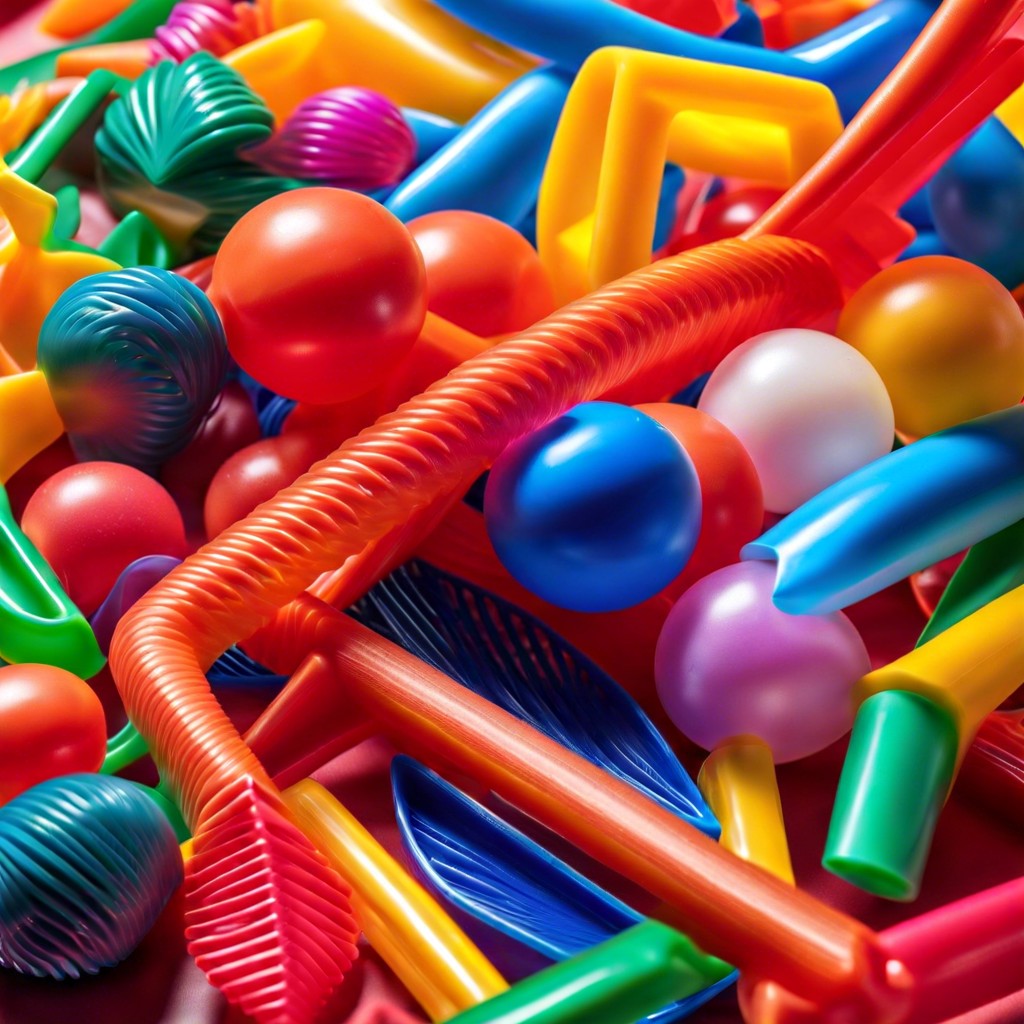Learn what plastic polymers are, their key characteristics, and how they are transforming construction.
Key takeaways:
- Plastic polymers form from monomers like Lego pieces.
- They are lightweight and flexible, yet durable.
- Excellent resistance to chemicals and moisture.
- Moldable for various shapes and recycling-friendly.
- Examples include Polyethylene, PVC, and PET materials.
Definition

Alright, let’s talk about what we’re dealing with here. Imagine you have a huge Lego set. Each Lego piece is a small molecule called a monomer. Click these monomers together in long, repeating chains, and voilà! You’ve got a polymer. Now, when these chains are made from plastic materials, we end up with plastic polymers.
Plastic polymers are like the Swiss Army knives of materials; they come in all sorts of shapes, sizes, and uses.
- They’re usually lightweight.
- They can be super flexible or rock solid.
- They’re pretty resistant to chemicals, which makes them durable.
Think of them like chameleons—they can adapt to a wide range of conditions and needs. All these characteristics make plastic polymers incredibly valuable in construction and just about everywhere else.
Properties
Plastics are famous for their flexibility – both literally and figuratively. They can be molded into a myriad of shapes, making them the chameleons of the material world.
One shining star of plastic properties is durability. These materials can withstand impacts that would turn other materials into rubble. Need a hard hat? Better make it plastic.
Weight is another biggie. Plastics are incredibly lightweight, which is why they’re used in everything from airplane parts to water bottles. No one wants to lug around a ton of extra weight.
Next, let’s talk about resistance to chemicals. Plastics can laugh in the face of corrosive substances, making them ideal for handling hazardous materials. Think of them as the immune system for your industrial applications.
Thermal insulation is another trick up their sleeve. Plastics don’t conduct heat well, which is why they’re in everything from oven mitts to coffee cups. Ever wonder why that cup of Joe doesn’t roast your fingers off?
Lastly, plastic polymers are often excellent electrical insulators. They keep the juice flowing where it should be while protecting you from zaps. Talk about a shocking revelation, right?
Structure
Polymers are pretty much the Lego bricks of the material world. Picture long chains of molecules, each one linking up with the next like a never-ending game of molecular Red Rover. These chains can be straight or branched, forming various shapes and sizes.
Their structure impacts everything. Whether they’re tough or flexible, clear or opaque, all boils down to how these chains of molecules are arranged.
Here are the key points:
- Monomers: The building blocks of polymers. Think of them as single puzzle pieces.
- Polymerization: The process where monomers join the party, creating a polymer chain.
- Linear vs. Branched: Linear polymers are like strings of spaghetti, while branched ones resemble a tree with many offshoots.
- Cross-linking: Sometimes, these chains connect with each other, adding strength. Imagine a fishing net.
- Crystalline vs. Amorphous: Crystalline polymers are orderly, like soldiers on parade, and are usually stronger. Amorphous ones are more like kids at recess: random and flexible.
Understanding these basics helps in knowing why some plastics are as bendy as a yoga instructor and others as tough as a bodybuilder.
Advantages
If you’ve ever marveled at how a plastic bottle can be both lightweight and unbreakable, you’re already on the right track. Plastic polymers come packed with a whole suitcase of benefits:
They are incredibly lightweight, so say goodbye to lugging around heavy materials. Strong but Flexible. Imagine Spiderman made of plastic; that’s how versatile these materials are!
Low Cost? Yes, please. Building with polymers often means saving a pretty penny. They resist the forces of Mother Nature, like moisture and chemicals, which means durability is their middle name.
They are also moldable. You can shape them into anything from a plumbing pipe to a decorative garden gnome. Lastly, they can be recycled. So, less guilt when you toss that water bottle; it’s probably coming back as a park bench.
Examples
One of the superheroes in the world of plastic polymers is Polyethylene. This stuff is everywhere: from plastic bags that fly away faster than unpaid bills to water pipes that don’t spring leaks at the worst moments. Then we have Polypropylene, the material that single-handedly makes food storage boxes, car parts, and even thermal underwear possible. Yes, your socks and car bumper might be distant cousins!
And let’s not forget about Polystyrene, the lightweight champion where disposable cups and packaging call home. Need insulation? It’s got you covered – literally. Meanwhile, PVC, or Polyvinyl Chloride if you’re not into the whole brevity thing, is what makes those robust, long-lasting pipes and vinyl flooring you probably spill coffee on.
Lastly, there’s PET – Polyethylene Terephthalate. It’s the reason you can chug your favorite soda from a bottle that won’t shatter when gravity pays you a surprise visit. Also, it’s the go-to for food packaging that keeps your snacks crisp and fresh. If there’s a versatile ensemble cast, this is it.
Recap




